Last updated on February 27, 2024

Boseiju, Who Endures | Illustration by Chris Ostrowski
Lands tend to be the bland side of Magic, a way to get to the fun part of slamming down creatures and raining instants and sorceries upon our enemies.
And that's when things are going well; lands aren’t bland when you’re mana-screwed… but that's not too entirely pleasant an experience, either.
But then we have utility lands: lands that do something else, which can go from making more mana (admittedly still bland), to pretty much everything else that you can print on a card!
Let's check the best of them, and find out how they can make themselves useful.
What Are Utility Lands in MTG?

Minamo, School at Water's Edge | Illustration by Jeremy Jarvis
In Magic, utility lands are lands that provide some other function besides tapping for mana.
By definition, they’re quite a varied lot. As we'll see in today's ranking, they go from enchantment recursion, to burning your foes down, to destroying other lands, to creating tokens, to generating lots of mana under the proper condition, and the list goes on.
On the other hand, that leaves out such MTG staples as Ancient Tomb, Cabal Coffers, Nykthos, Shrine to Nyx, or Gaea's Cradle. Although they’re excellent lands overall, they’re a bit “boring” in the sense of just producing a ton of mana when tapped and doing nothing more – which of course sells them very short (they’re an excellent addition to any deck that needs a ton of mana!). On the other hand, it means they don't have that “doing other thing besides tapping for mana” that sets utility lands apart.
Honorable Mentions: Tolarian Academy + Library of Alexandria
There's one fairly objective metric for finding out which are the most powerful cards in Magic: the banned list. The more formats a card is banned from, the more things that card broke.
If we go by that metric, Tolarian Academy and Library of Alexandria are off the charts: They’re banned in every format except Vintage, and even in that format they’re two of the only three lands that are restricted to a single copy.
That also means they should be #1 in every land ranking, but that would make things boring… so honorable mention it is!
Honorable Mention: The Fetch Lands
Fetch lands aren’t usually included among utility lands, even though they do a lot of things. I'll respect the wisdom of the crowds here (and everybody knows fetch lands are awesome, anyway), but I’ll point out a corner-case use that fetch lands have and that sometimes goes unnoticed: shuffling.
If your deck has any way to see or manipulate what's at the top of your library (like with Sensei's Divining Top or Bolas's Citadel), the fetch lands' shuffling-on-demand has quite a bit of utility. Any time you don't like what you see, you can shuffle it away and hopefully find something better.
Honorable Mention: The Creature Lands
“Creature lands,” sometimes nicknamed “manlands,” is MTG lingo for “lands that can turn themselves into a creature, usually until end of turn.” There are quite a few of them, and if sets like Wilds of Eldraine and The Lost Caverns of Ixalan are any indication, we'll keep seeing more: Each of those MTG sets added about half a dozen, and some of them are quite impactful. For example, Restless Anchorage has become a staple in Raffine Esper decks, one of the strongest in Standard.
Creature lands deserve their own detailed ranking, so for today let’s just say that creature lands are often an excellent mana sink. Since they often turn back into lands during your opponent's turn, they tend to avoid sorcery-speed creature removal.
#40. Maze's End
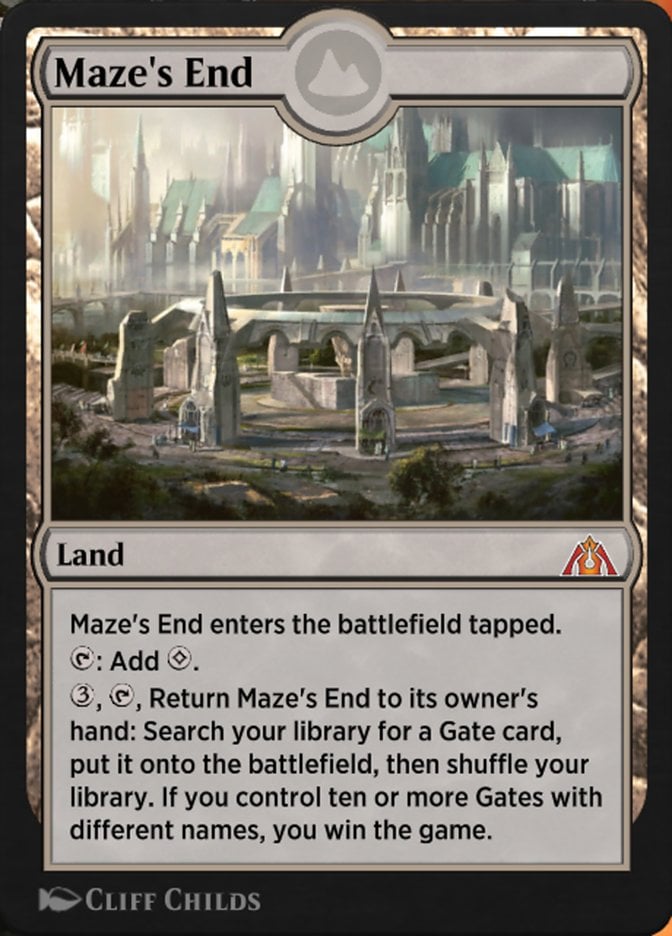
Most utility lands provide some bonus feature that helps you win the game.
Maze's End wins games it all by itself!
Or, well, with a whole deck designed around it, but still: If winning ain't useful, I don't know what is.
You'll notice that many utility lands share the downside of entering the field tapped and producing only colorless mana.
#39. Plaza of Heroes
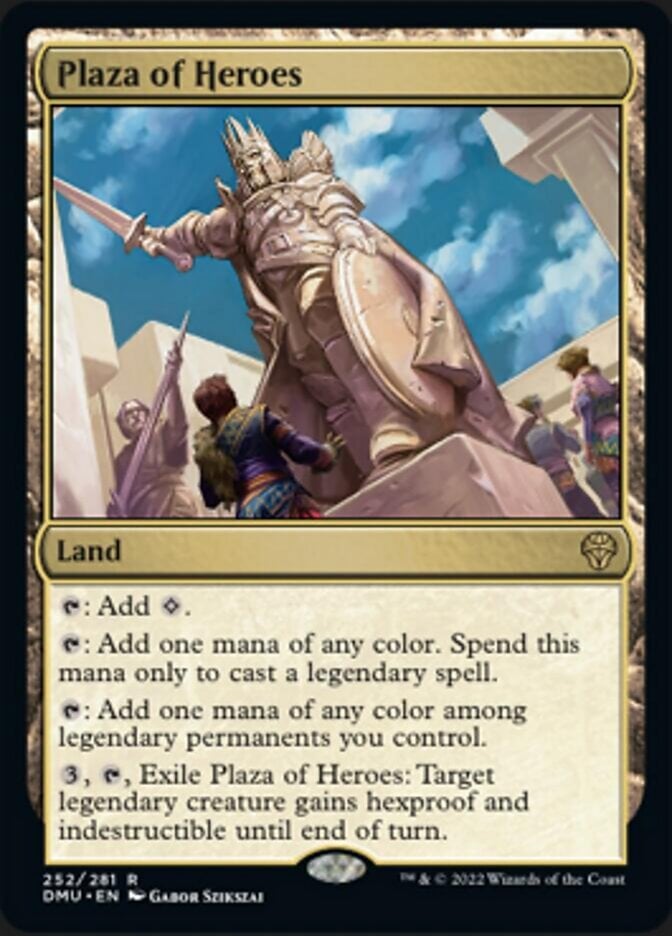
Brought to us by Dominaria United, Plaza of Heroes has become a staple both in Commander and in Standard, where it shines in Esper decks. Turns out that amazing mana fixing plus insurance for your win condition via hexproof can go a long way to make a card great!
#38. Alchemist's Refuge
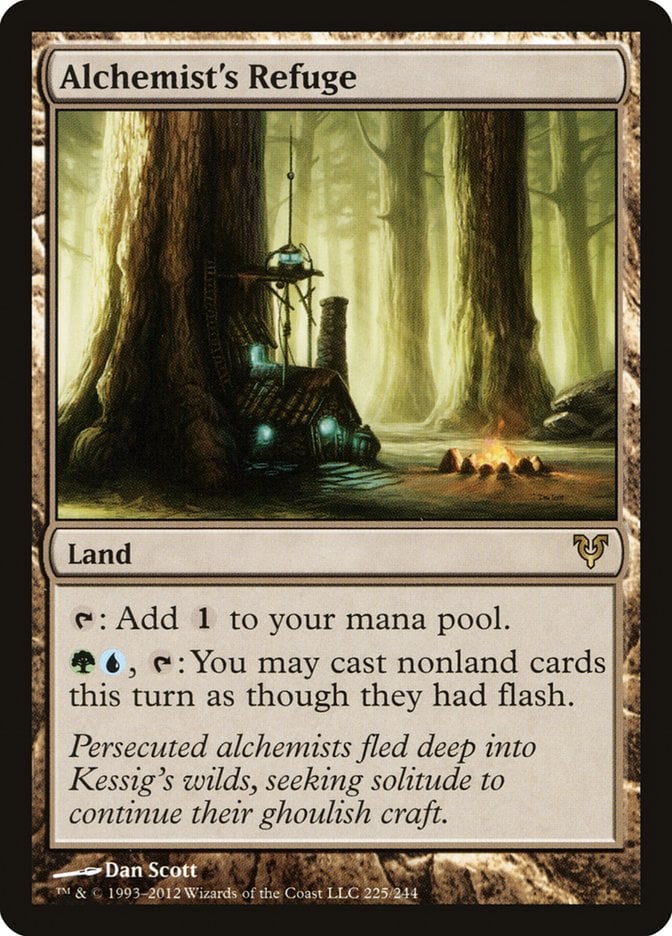
Now this is the kind of utility that can change games a lot: For , Alchemist's Refuge lets you play all your spells during your opponents' turns, including dropping your creatures at flash speed and turning all your sorceries into instants.
The color identity limits it to Simic+ decks, which is definitely a negative from the point of view of flexibility, but Alchemist's Refuge offers a game-changing effect that lands don't usually have.
#37. Mosswort Bridge

For decks that love tossing big bodies on the board (read: every green deck ever), Mosswort Bridge is just superb: You get card filtering, card draw, and often a large discount all in a single card.
This land also generates colored mana – something many lands in this ranking do not.
#36. Gavony Township
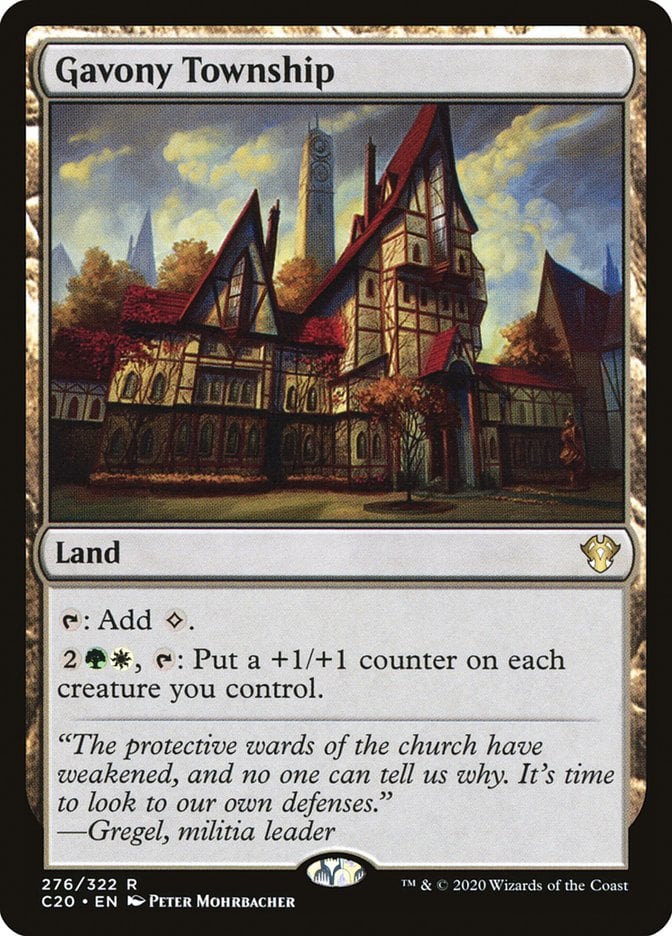
Having a dual-colored cost for its activated ability is a strike against this land since it imposes a very specific deckbuilding requirement… but on the other hand its specificity is quintessentially Selesnya, and just loves counters showered on top of its creatures.
As one of the best +1/+1 counter cards, Gavony Township is often seen buttressing go-wide armies under Tayam, Luminous Enigma‘s command.
#35. Seat of the Synod + Great Furnace + Ancient Den
Seat of the Synod, Ancient Den, and Great Furnace from Mirrodin are an interesting oddity: artifact lands. And very good ones: Seat of the Synod is arguably one of the best blue artifacts, Great Furnace is one of the best red lands, and they've all earned a ban in Modern.
If you find it a bit puzzling why these lil' artifacts are so strong, keep in mind that they’re lands, meaning that you play them (rather than cast them) from your hand, so they dodge counterspells. Since their ability is a mana ability, it's nigh-impossible to stop them from tapping.
Seat of the Synod and Great Furnace come up from time to time in Commander, but they’re staples in Pauper and playable in Legacy.
#34. Sokenzan, Crucible of Defiance
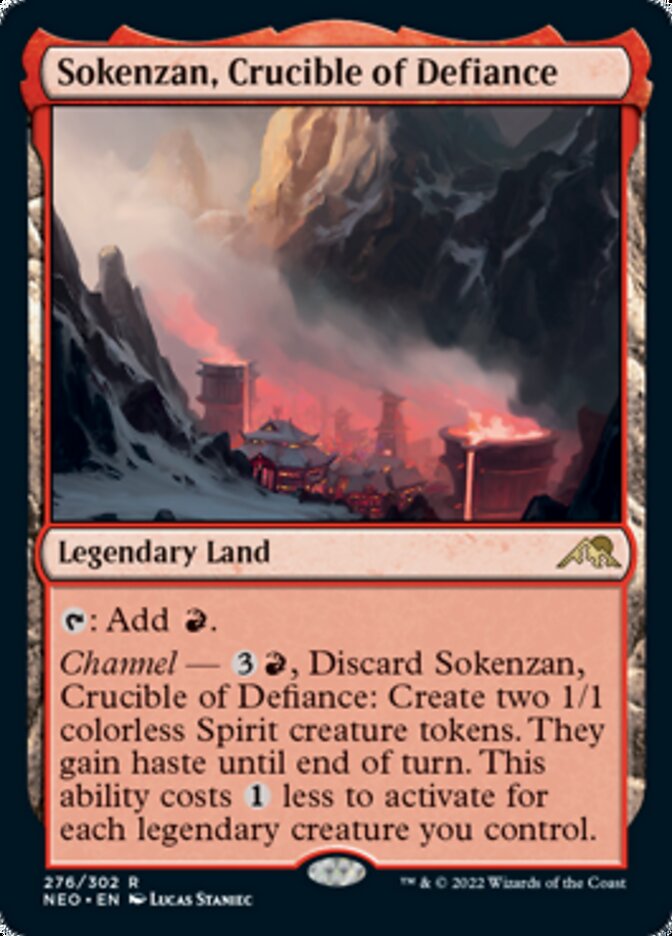
Back in 2005, the original Kamigawa block introduced the channel ability. Nearly 20 years later (or more than a millennium, if you go by Kamigawa's timeline), Kamigawa: Neon Dynasty brought the ability back and slapped it on five legendary lands… all of which make the cut today.
Sokenzan, Crucible of Defiance is perhaps the tamest of the bunch, but it’s good enough to be a staple in Rakdos and Red Deck Win decks in Pioneer and Standard, and not bad in any Commander deck in need of a couple of small hasty bodies in a pinch.
Notice that channel works at instant speed, and it's not casting (it's an activated ability) – it can't be denied by traditional counterspells.
#33. Castle Locthwain
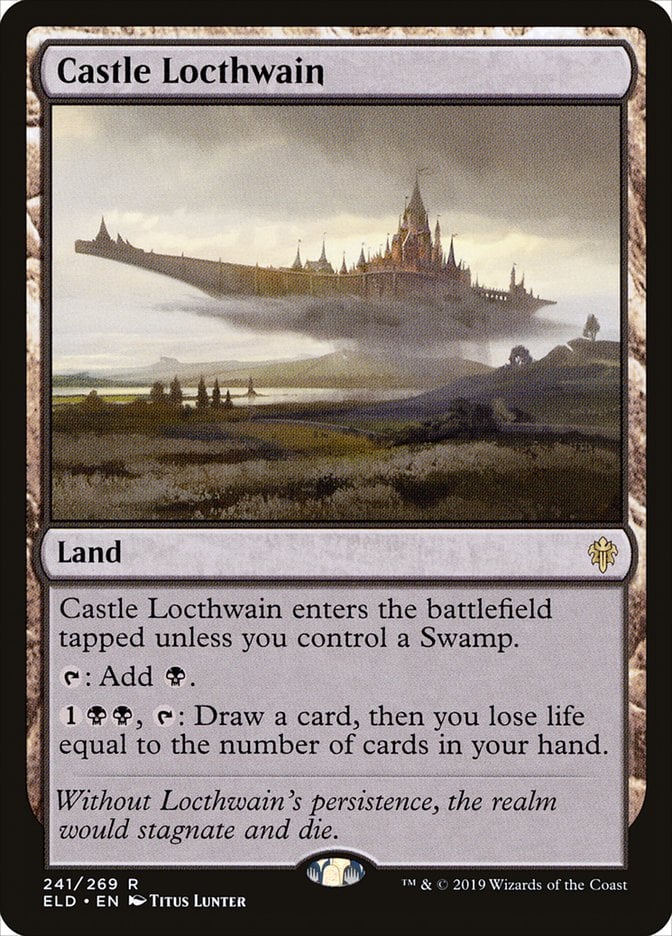
Throne of Eldraine‘s Castles make up one of the best land cycles in Magic, and Castle Locthwain is the best of the bunch: a multi-format staple that sees play in Modern, Pioneer, and Commander.
#32. Cephalid Coliseum

Threshold is a bit of an obscure ability word from Judgment, but fairly straightforward: As long as you have seven cards in your graveyard, you'll be able to activate the card's threshold ability (in that sense it's a bit like Descend 8 from The Lost Caverns of Ixalan).
The ability to dig further into your deck for just makes Cephalid Coliseum one of the best lands in blue, and it’s also useful for milling your foes.
#31. War Room
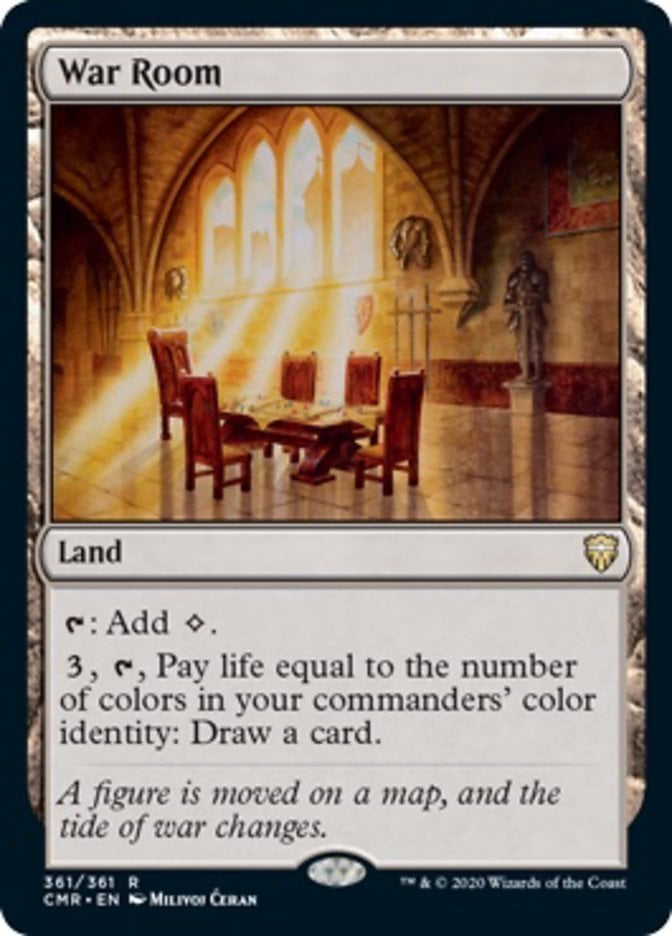
War Room is a neat design: 4- or 5-color decks have no use for a card like this (since they'll be able to find better options among the cards in their colors), while mono- or dual-color decks are a perfect fit whenever the MTG color pie doesn't give them good card-draw effects.
This land is only useful in Commander, of course, but it's one of the most flexible lands with “commander” in its text.
#30. Dryad Arbor
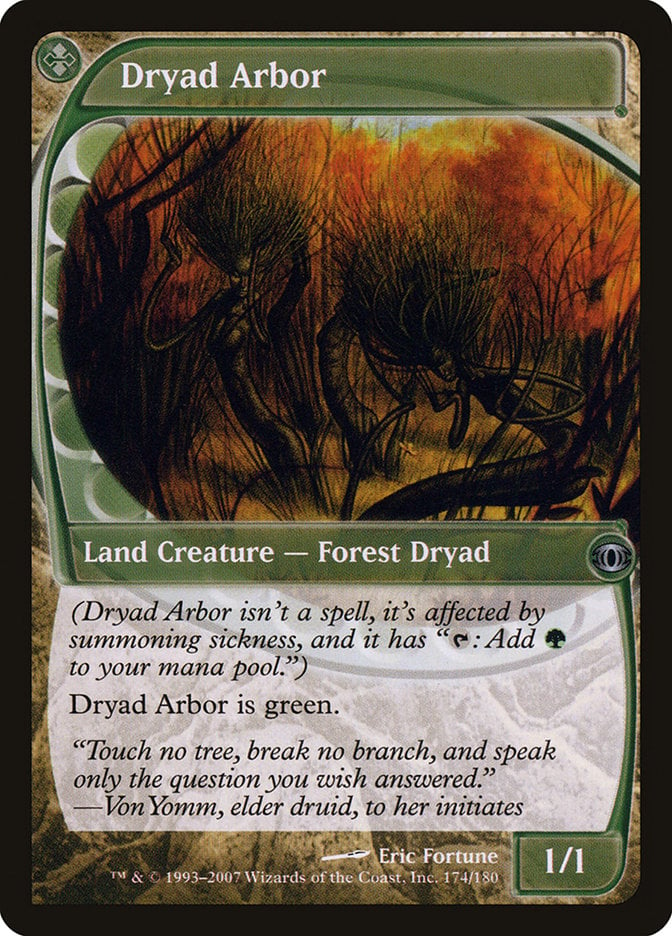
I listed creature lands in my honorable mentions, but Dryad Arbor is something different: a land creature.
Which may seem like I’m just shuffling words around, but word order matters here: This dryad doesn't turn into a creature (like creature lands do) but rather is a creature, and therefore enjoys the benefits of both card types.
For example, it can't be countered: Since it's a land, you play Dryad Arbor rather than cast it. Tutors for any of its types work: Since it’s a forest, you can fetch it (at flash speed!); but since it's also a creature, it's relevant with cards like Green Sun's Zenith or Natural Order.
#29. Emeria, the Sky Ruin

Reanimating never gets old!
You have to jump a handful of hoops to get there; this isn’t a land that you just toss into a deck and call it a day. But if you have a clear game plan to support it, Emeria, the Sky Ruin is pretty damn awesome at its gravediggin' job.
#28. Homeward Path

Homeward Path‘s utility is extremely narrow, but the best of the best if you plan on gifting creatures to your foes and then yanking them back.
The kind of trick that, say, Jon Irenicus, Shattered One or Zedruu the Greathearted would like.
#27. Hall of Heliod's Generosity

Hall of Heliod's Generosity is another example of a very narrow use case, but extremely useful for any deck that’s in the market for some heavy-duty enchantment recursion.
#26. Shizo, Death's Storehouse
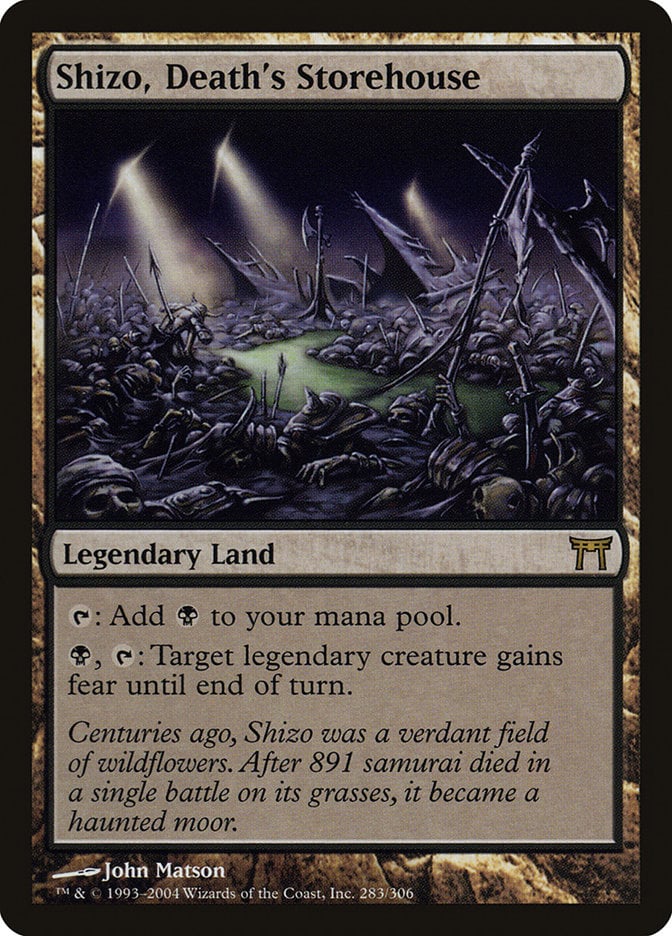
The Commander format loves legendary lands since the legend rule is no big deal if you can't run more than one copy of the card anyway, and Shizo, Death's Storehouse is yet another member of that legendary club.
Fear is a fairly rare keyword, and one of the best forms of evasion: Only black creatures or artifacts can block an attacker with fear. Unsurprisingly, Shizo, Death's Storehouse shows up a lot in Yuriko, the Tiger's Shadow decks, as well as any black-based deck with a penchant for ninjas and saboteurs.
#25. Wasteland

Most utility cards are about doing something more, besides generating mana.
Wasteland believes in a “Less Is More” approach. Also in an “I'm taking you down with me!” approach!
It may not be the best at the job, but if your deck needs a bit of land destruction to get the job done, you can't go wrong with Wasteland.
#24. Eiganjo, Seat of the Empire

The second of the NEO channel lands, Eiganjo, Seat of the Empire would be fairly bad as just a removal spell.
But that's Magic's magic: Mix some unimpressive, plain-vanilla mana-generation capacity with mediocre removal, and you get one heck of a multi-format all-star that shows up in pretty much every format where it's playable. It’s particularly potent in Pioneer.
#23. Academy Ruins
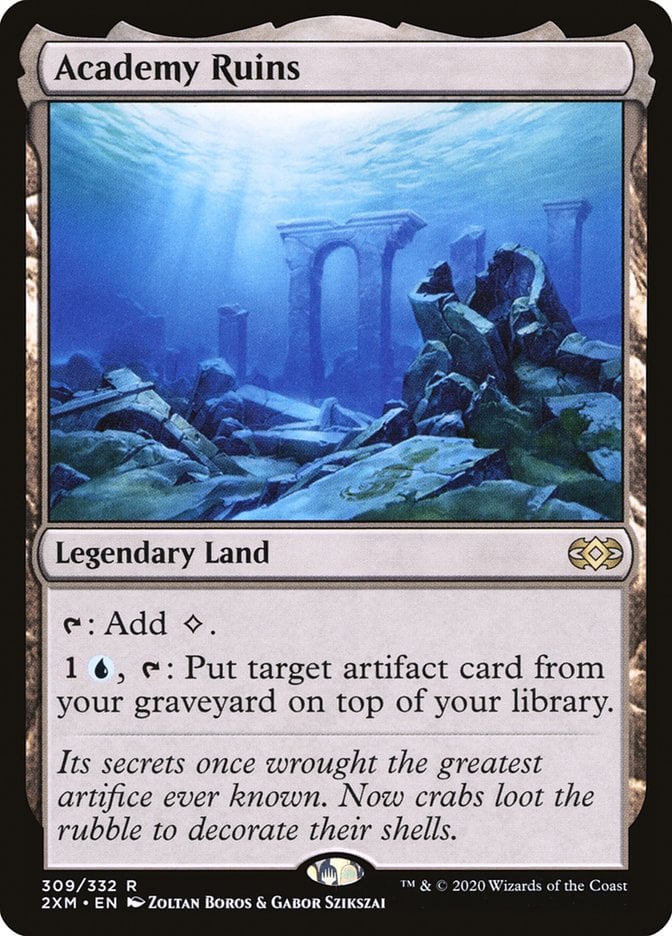
Hall of Heliod's Generosity, but for artifacts. That makes Academy Ruins fit a whole lot more decks, given how prevalent artifacts are!
#22. Command Beacon
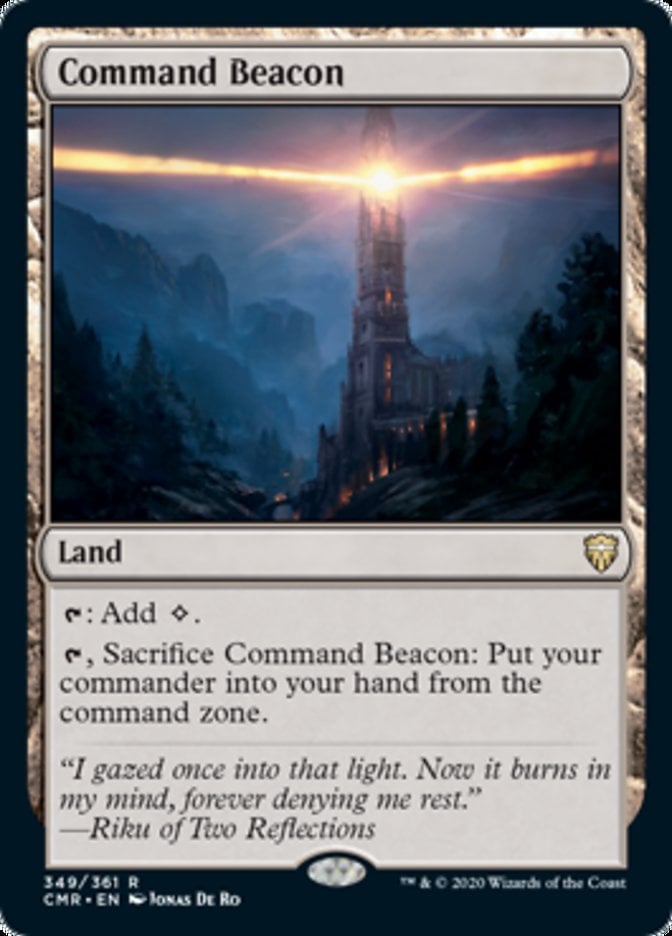
If MTG lands had real-life jobs, Command Beacon would be an accountant.
The type of cunningly shrewd accountant that would smirk and say: “About death, yeah… nothing we can do there. Can't avoid that. But, taxes? Those aren’t entirely unavoidable… You see, you only pay the commander tax from the command zone. Your hand is a tax-free zone in that regard. What's more: Casting your commander from hand won't add to the commander tax should you later be forced to cast it from the commander zone. We're doing everything by the book here, my friend!”
#21. Inventors' Fair

There are tons of cards that put artifacts in play, like Treasure or Food token generators, making Inventors' Fair‘s condition easy to meet.
Its life-gaining ability is nice, but we're here for the tutoring effect. This is a truly colorless land, so it fits any deck that needs a specific artifact to close out the game or thwart its foe's plans.
#20. Kessig Wolf Run

Kessig Wolf Run adds that spicy “Gruul Smash!!” tang that decks like so much: Huge power is yummy, and trample makes it all the tastier.
You can also use it defensively by threatening to turn a chump-blocker into a huge body. But, yeah, the best defense is a good offense!
#19. Karn's Bastion

One of the best proliferate cards and available to any deck, Karn's Bastion shines in superfriends EDH decks but can round up everything from poison strategies to lists that go heavy on +1/+1 counters.
#18. Valakut, the Molten Pinnacle
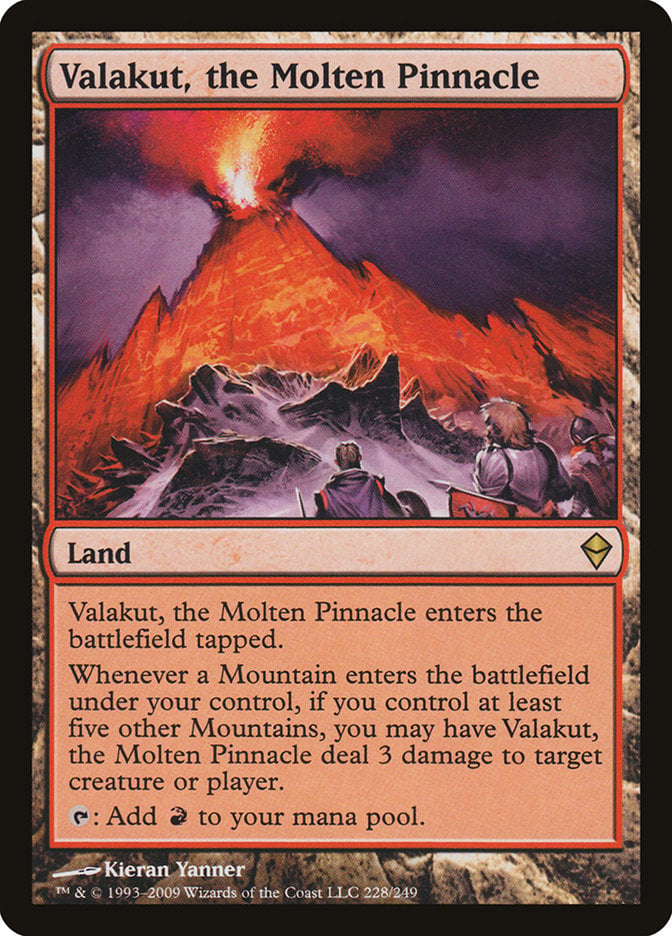
Valakut, the Molten Pinnacle does the most mountain-y thing that (Magic) mountains do, namely burn everything in sight.
By the way: If you put several mountains in play at the same time, Valakut, the Molten Pinnacle triggers once for each of them (provided you have at least five others). Which is what makes Valakut terrifying when paired with Scapeshift.
#17. Field of the Dead
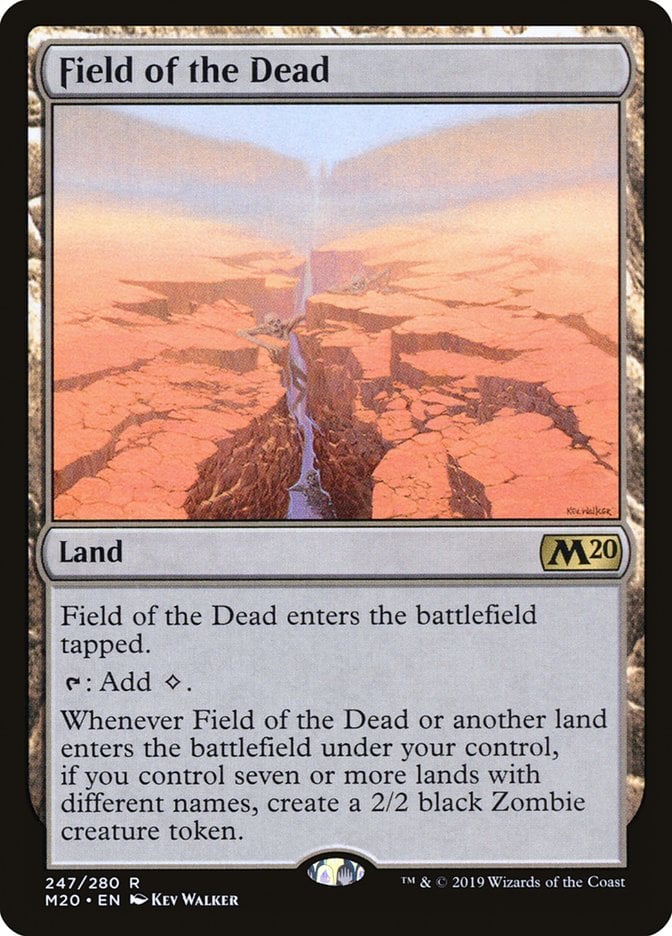
Field of the Dead provides a somewhat similar effect to Valakut, giving you an advantage with every extra land you play if you meet its other conditions.
The lands need to be different in this case – not too much of a hassle in Commander, and being colorless means that Field of the Dead fits any deck that may need a zombie horde or two. And Field of the Dead‘s ETB counts itself for the trigger.
#16. Buried Ruin
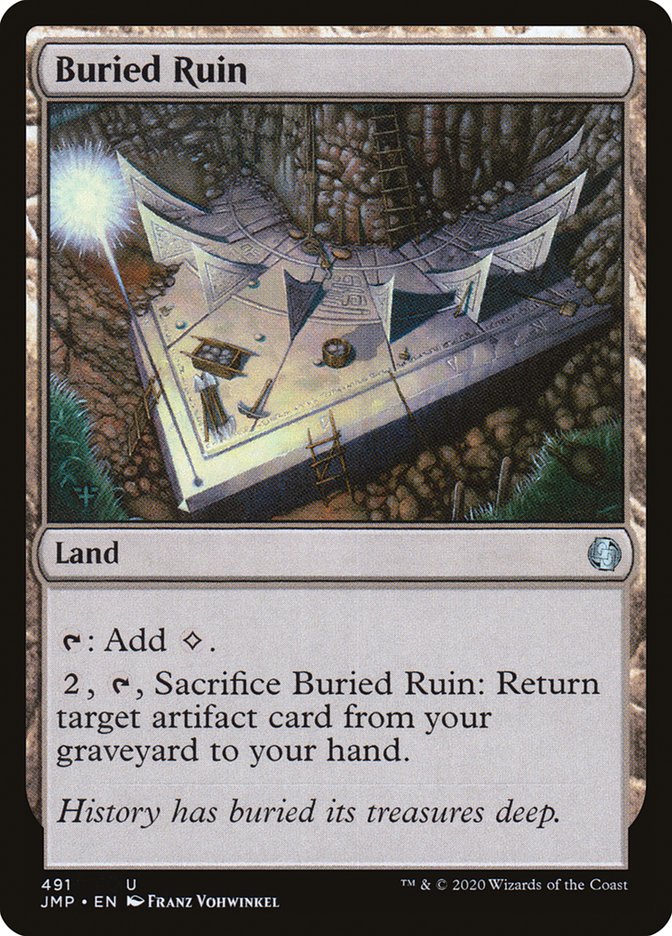
We all have a plan, until opponents kill our win con. That's why good plans need some redundancy: Buried Ruin is a great example of a card that never shines just by itself, and many times it’s just a source of colorless mana. But when push comes to shove, it has your back and reanimates the exact artifact you need to win.
Of course, sometimes tutoring your artifact straight from your graveyard was the plan all along!
#15. Phyrexian Tower
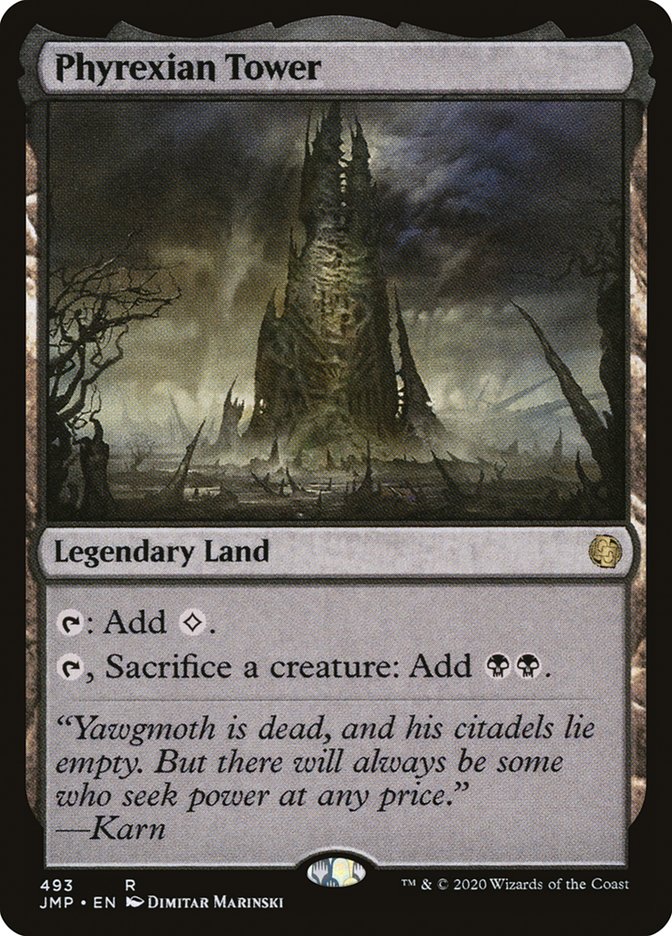
Phyrexian Tower has “sacrifices must be made” written all over it. Which is to swamps what raining fire is to mountains, making this legendary land one of the best black lands and a good fit for any aristocratic black deck that knows what it takes to win.
Notice that this is a mana ability, so it doesn't use the stack and can't be Stifle‘d – in other words, if you have a death trigger you need to make sure goes through, Phyrexian Tower has you covered.
#14. Takenuma, Abandoned Mire
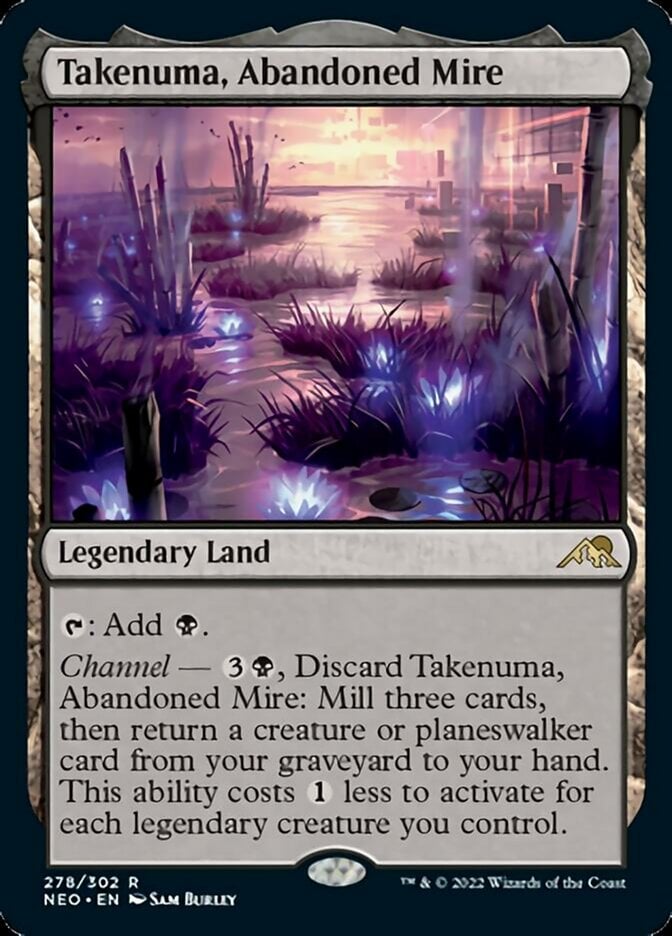
Top 3 among the NEO channel lands and yet another great black land, Takenuma, Abandoned Mire provides self-mill and return-to-hand services in one neat package. It sees quite a bit of play in Commander, but it truly shines in 60-card formats as part of top-tier decks in Modern, Pioneer, and Standard.
#13. Strip Mine

Three lands are so off the charts that they’re restricted in Vintage: Tolarian Academy, Library of Alexandria, and Strip Mine. A tad less terrifying than the other two and therefore not banned in Commander, Strip Mine is still scary enough to be barred from everywhere else.
This badland is the gold standard for land destruction, and strictly better than Wasteland. Not every deck wants or needs such an effect, but this is the best land you can find for those that do.
#12. Myriad Landscape
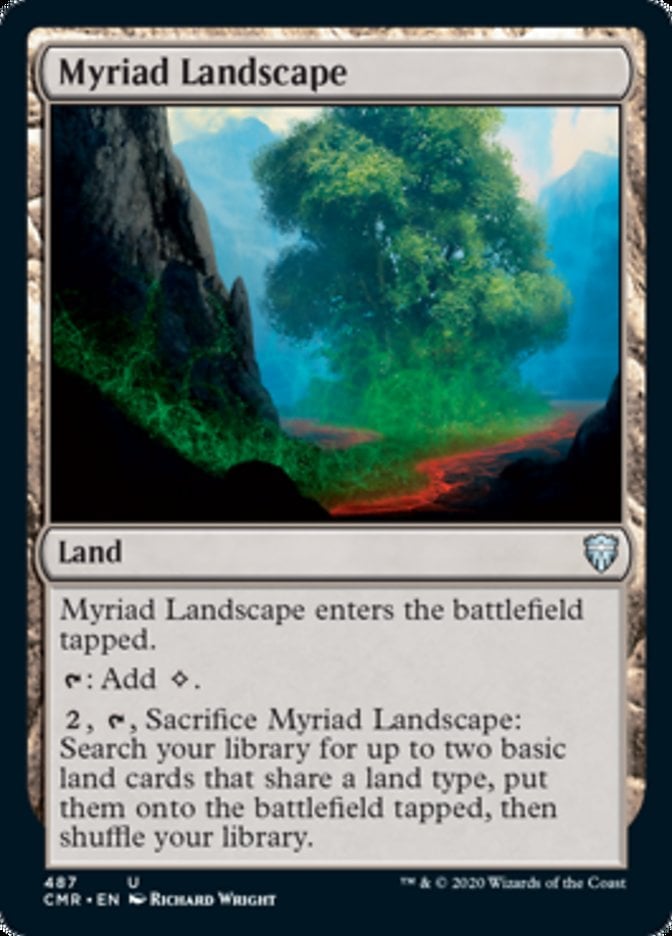
Myriad Landscape is a bit clunky (it enters tapped and costs 2 mana to activate), but you get twice the ramp than you would with a fetch land, can opt to use it as a mana source until you decide to sacrifice it, and best of all, can fit it in any deck. The latter is its main strength, buttressing mono- or dual-color decks that may not have good access to card draw and making it one of the best search-land effects.
By the way: You can always choose to fetch just a single land, above all if you've run out of pairs.
#11. Mystic Sanctuary
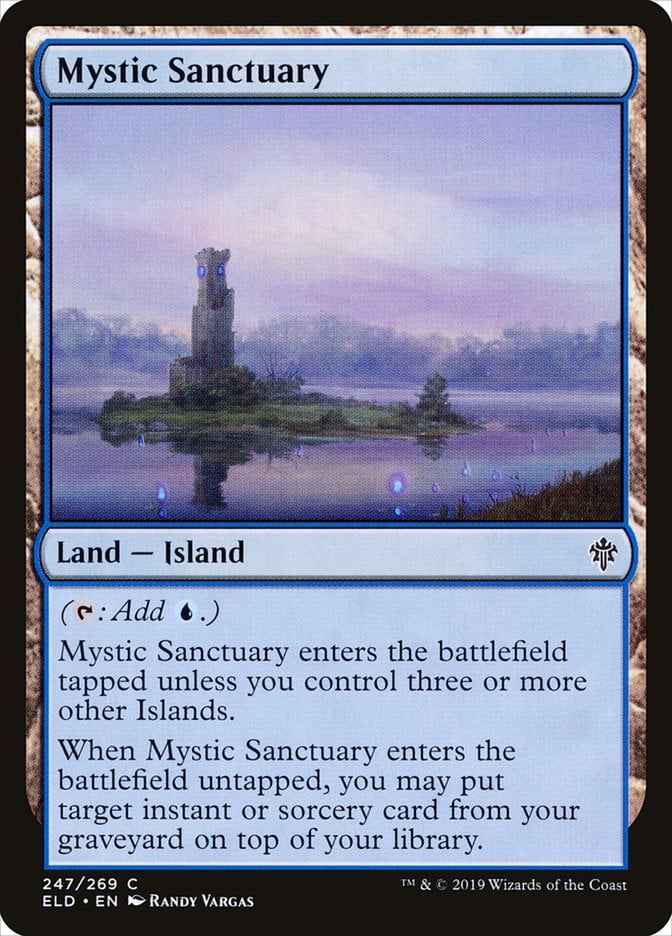
Mystic Sanctuary is a member of another card cycle from Throne of Eldraine. Nobody remembers the other four cards, but this mischievous sanctuary has broken a few things with its recursion capabilities and proudly carries its bans in Modern and Pauper.
#10. Otawara, Soaring City
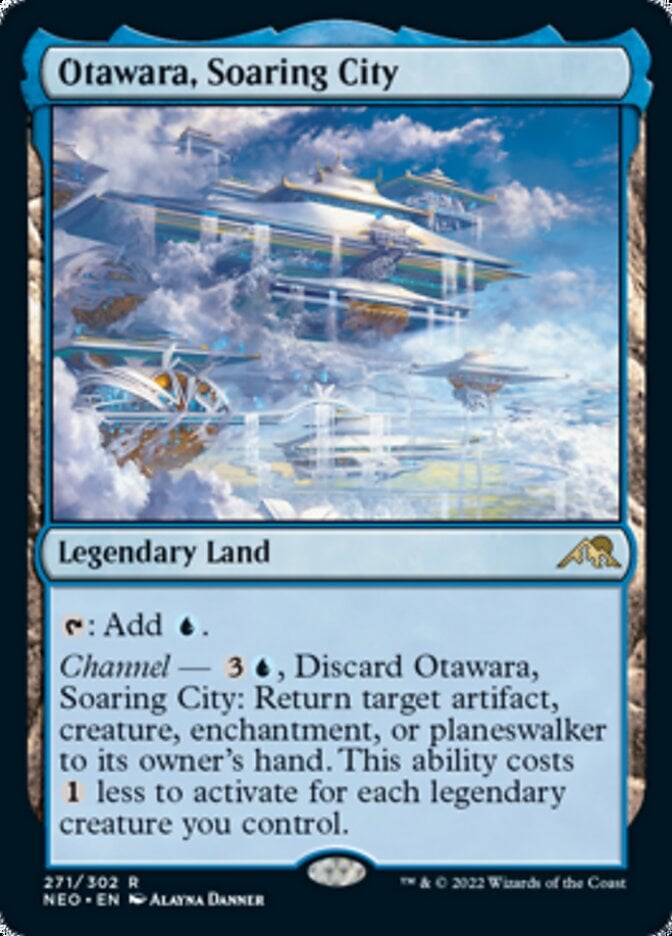
On to the #2 of the NEO channel lands! Otawara, Soaring City is a multi-format all-star that sees play in more than one top-tier deck.
Otawara, Soaring City can bounce both your and your foes' creatures, making it either a good tempo tool to delay your opponent's plan or a bit of insurance to keep your wincon out of harm's way.
#9. Path of Ancestry
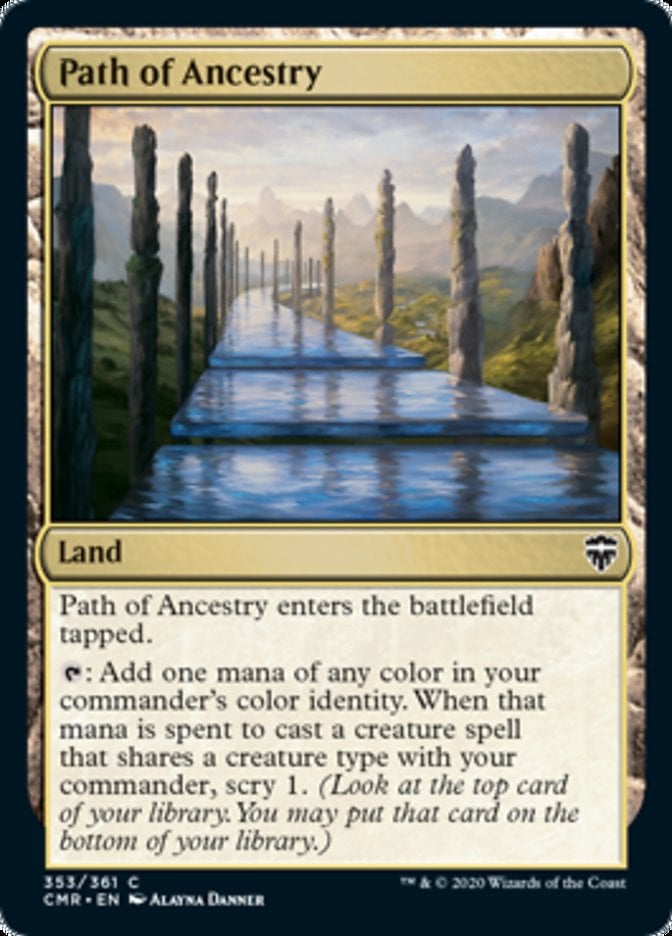
Unlike many cards in today's ranking, Path of Ancestry can tap for any color of mana that your EDH deck may need. That by itself would make it super useful, but it wouldn't meet the “doing something else on top of tapping for mana” definition for a utility land.
Add scry on top, though, and it both pushes this land to “excellent” and makes it a bona fide utility land – notice that your commander shares creature types with itself!
#8. Rogue's Passage
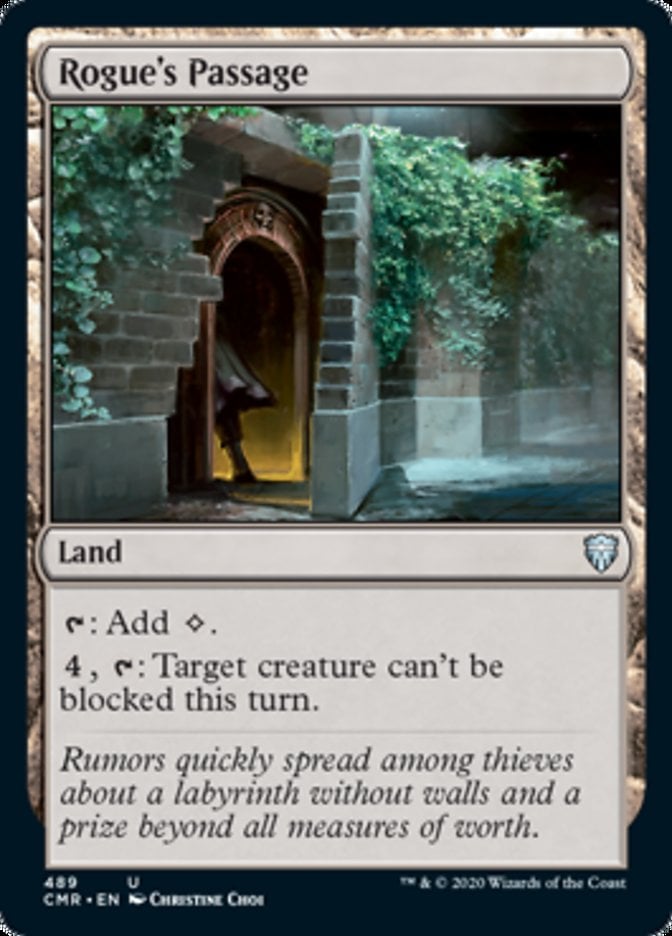
Rogue's Passage may come off as a bit of a cheap trick, but hey, that's what rogues are about. It’s not a career path you choose if fair fights are what you love!
This land doesn't see much play outside of Commander, but its massively popular in the multiplayer format. Notice that it isn’t limited to your creatures – if the table's politics and alliances so require it, you can give unblockable to Player A's creature and let it past Player B's defenses this turn.
#7. Reliquary Tower
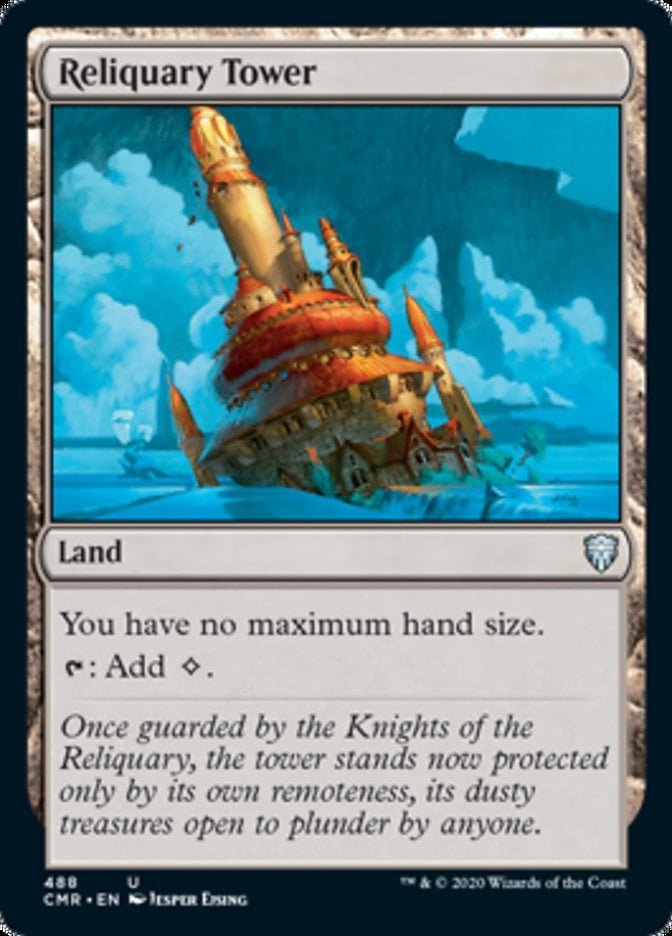
Although practically unplayable in 60-card formats, Reliquary Tower is the most popular utility land in Commander at the time of writing, according to EDHREC. You can draw as much as you want without being forced to discard down to seven by the end of the turn, and it hampers any foe that loves wheel effects and forcing everybody to draw too many cards.
#6. Bojuka Bog

While Reliquary Tower is the most popular utility land in Commander when all decks are considered, Bojuka Bog is the most common if one of the deck's colors is black: Nearly one out of three of your swamp-spewing foes will have it in their deck, so keep that in mind if graveyard hate is the kind of effect that makes you cry.
And it's not just a multiplayer staple: Bojuka Bog can be found in pretty much every format.
#5. Cavern of Souls
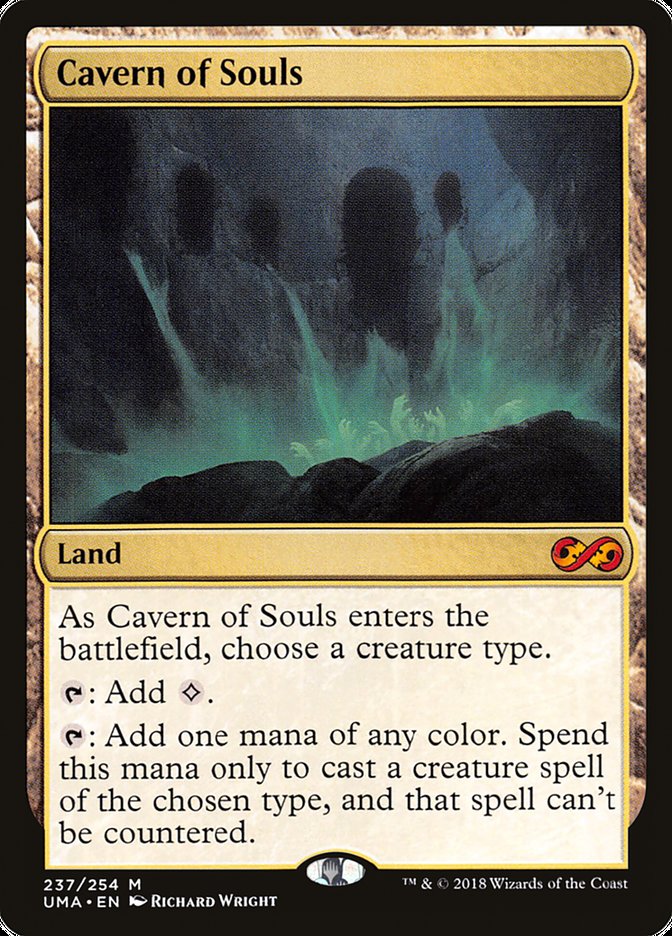
This is what a multi-format staple looks like, with ample showings in decks from Legacy to Standard, where Cavern of Souls managed to push Green Domain Ramp as one of the best decks in the format by letting it drop an uncounterable Atraxa, Grand Unifier or Archangel of Wrath.
#4. Minamo, School at Water's Edge
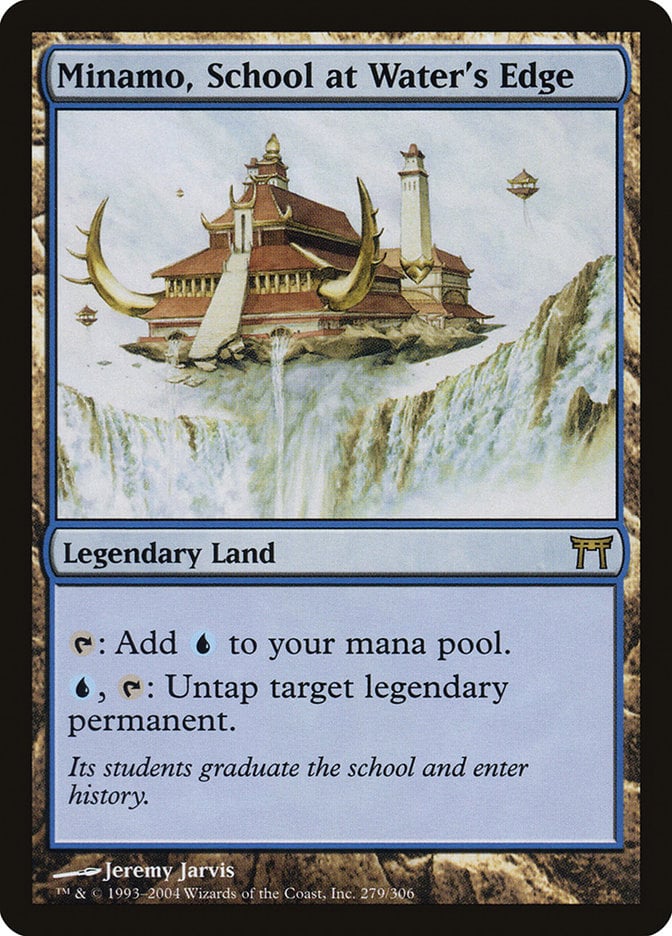
Kamigawa looks like a plane with a penchant for amazing lands, and Minamo, School at Water's Edge is another example. It's one of the best legends-matter payoffs, and it's a legendary land, too. It sees tons of play across all formats, often paired with The One Ring and anything that enjoys tapping and untapping a lot.
#3. Urborg, Tomb of Yawgmoth
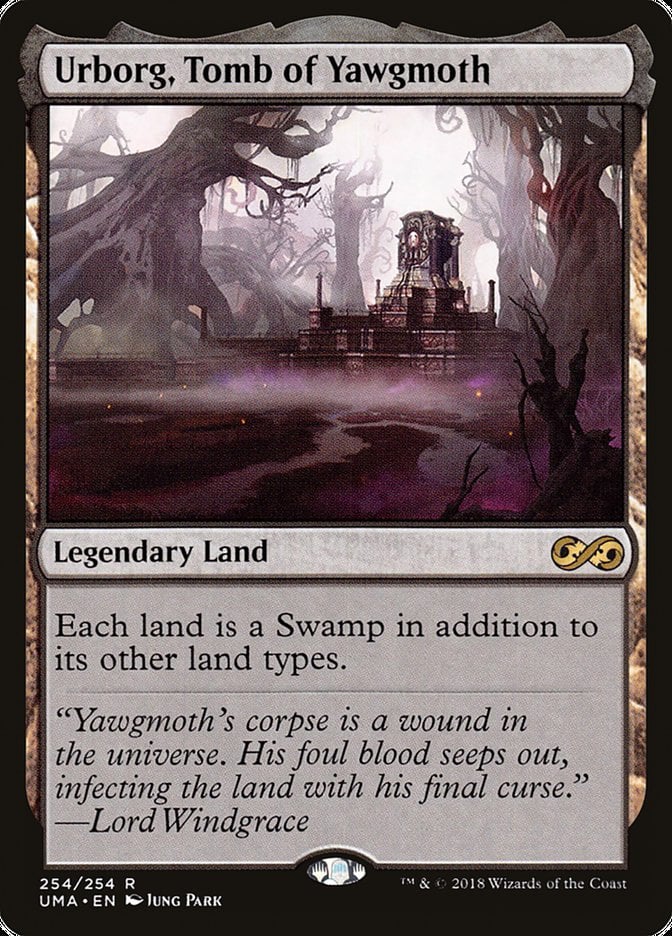
Most lands in this list have activated or triggered abilities. The infamous Urborg, Tomb of Yawgmoth goes for a different approach: It changes every land on the board.
This includes Urborg itself, so it's a swamp as soon as you play it.
And in case this may be confusing: The wording “is a swamp in addition to…” means that every land gains the “swamp” type, and they can all tap for , but they still retain all their other types and abilities. If you have a basic land like an island, it's now a swamp island that can tap for either (its new swamp-y ability) or for (its original island-y ability), and it's still a basic land despite all the things it can now do.
Nonbasic lands, for their part, still retain all their text, so Strip Mine can still kill other lands, legendary lands are still legendary, etc.
Urborg, Tomb of Yawgmoth is a house (or, well, a tomb… but one house of a tomb!) in most formats where it's legal. It's often paired with Cabal Coffers, one of the most iconic cards from Torment (itself nicknamed “the black set” given the number of cards it has that care about you having swamps).
#2. Boseiju, Who Endures
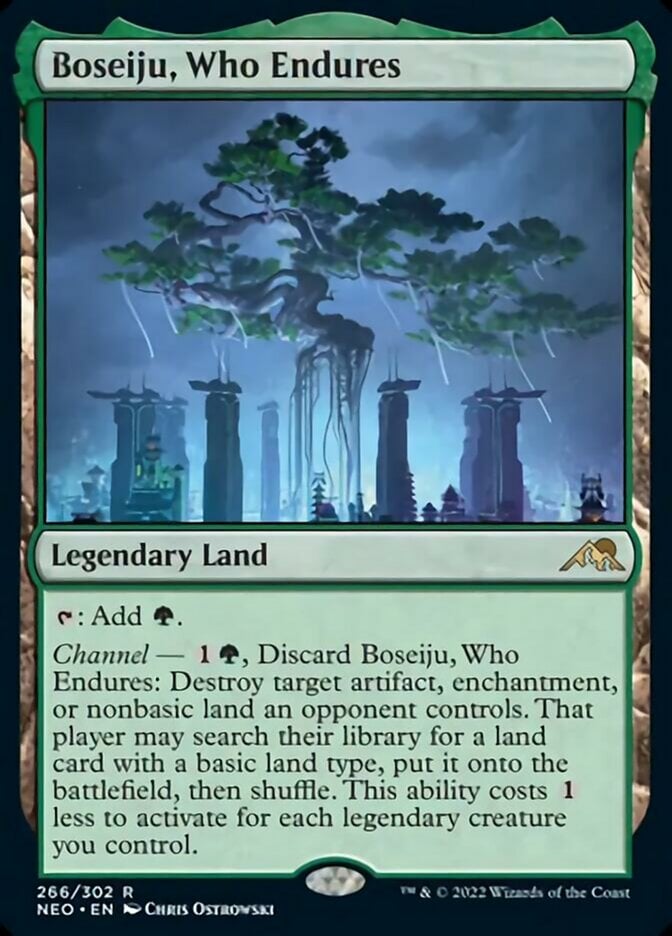
The Top #1 among the Kamigawa: Neon Dynasty channel lands, Boseiju, Who Endures provides an excellent way to do one of the greenest things in Magic: nuke pesky enchantments and artifacts. And with a side dish of killing pesky nonbasic lands!
Green has a ton of ways to recur a land from the graveyard, making it easy to return Boseiju to your hand after channeling it. The ability's mana cost is also notably cheaper than the other channel lands, making Boseiju, Who Endures all the tastier.
#1. Urza's Saga
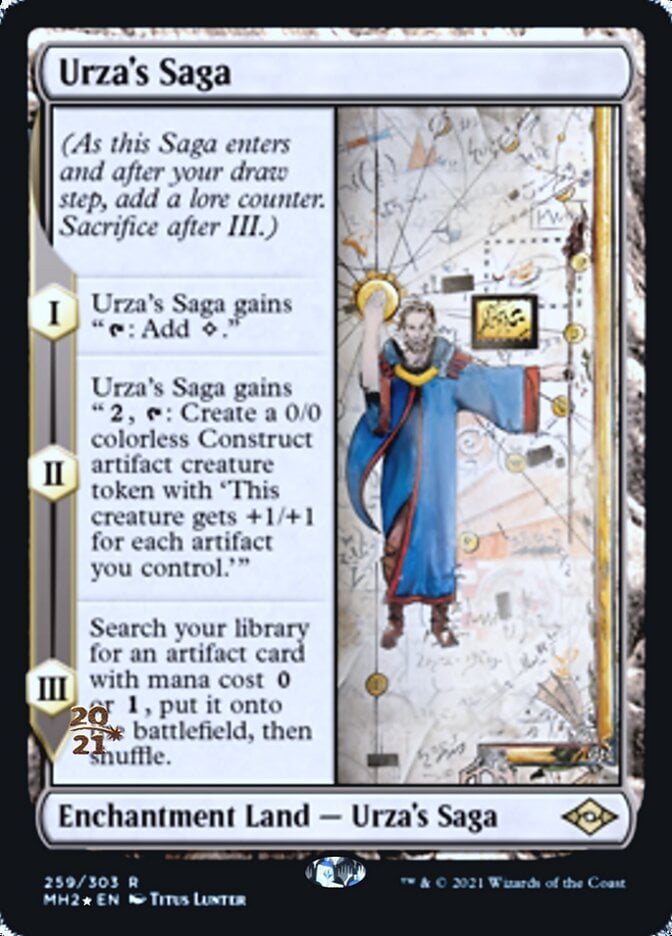
Urza's Saga is the tops among utility lands. This enchantment land is one of the most useful lands in Magic and one of the best sagas in the game, and it’s been making waves since its release in Modern Horizons 2.
Urza's Saga provides a bit of mana. Then it can make a Construct on its second turn, and a second on its third turn: You can activate it while the sacrifice trigger is on the stack. And then it tutors a cheap artifact (like whatever mana rock you need next) that also helps fatten the created Constructs.
Like Dryad Arbor, it can’t be countered when played from hand (you play it, rather than cast it).
Best Utility Lands Payoffs
There's no intrinsic synergy per se between utility lands, and the best among them tend to do very different things (from providing a lot of extra mana to destroying lands and actually reducing your own mana). There are some obvious synergies between some utility lands, like Cabal Coffers and Urborg, Tomb of Yawgmoth, but those are the exceptions rather than the rule.
The same is true for payoffs. There are of course specific payoffs for playing lands (like landfall effects), but those apply to any land, not utility lands specifically.
It's more about what job you need done, and whether a utility land is the best tool for that job. If your deck is all about land destruction, its payoffs naturally align with what Strip Mine does.
How Many Utility Lands Should You Play in Commander?
Utility lands are so varied that it's not about an optimal number, but rather about getting a certain job done.
Some of those jobs are generic enough, and the land in question is good enough even in games when you don't need the specific job done, that some utility lands can fit pretty much any deck of the appropriate colors. The Kamigawa: Neon Dynasty channel lands are a good example: There's often an artifact or enchantment you need nuked, but when that's not the case Boseiju, Who Endures is a perfectly good green source.
In the case of very specialized roles, like recurring an enchantment with Hall of Heliod's Generosity, it depends on how badly (or not at all) your deck needs to get that job done.
In short: There's no fixed or optimal number for utility lands. It all depends on which bases you need covering, how many cards you want to cover each base, and whether a utility land (rather than an instant, sorcery, or another type of permanent) is the best player for that role.
Wrap Up

Alchemist's Refuge | Illustration by Dan Scott
And that rounds up our ranking of best utility lands in MTG!
I hope it's been a useful list, and do take a look at Scryfall and EDHREC for other options. Utility lands are a varied lot pretty much by definition, and there may very well be a land or two that are extremely niche and narrow but happen to fit your deck's game plan like a glove.
If you have any comments, feedback, or further questions about these token generators, do drop us a comment or stop by the Draftsim Discord for a chat.
And may you find the land you need!
Follow Draftsim for awesome articles and set updates:
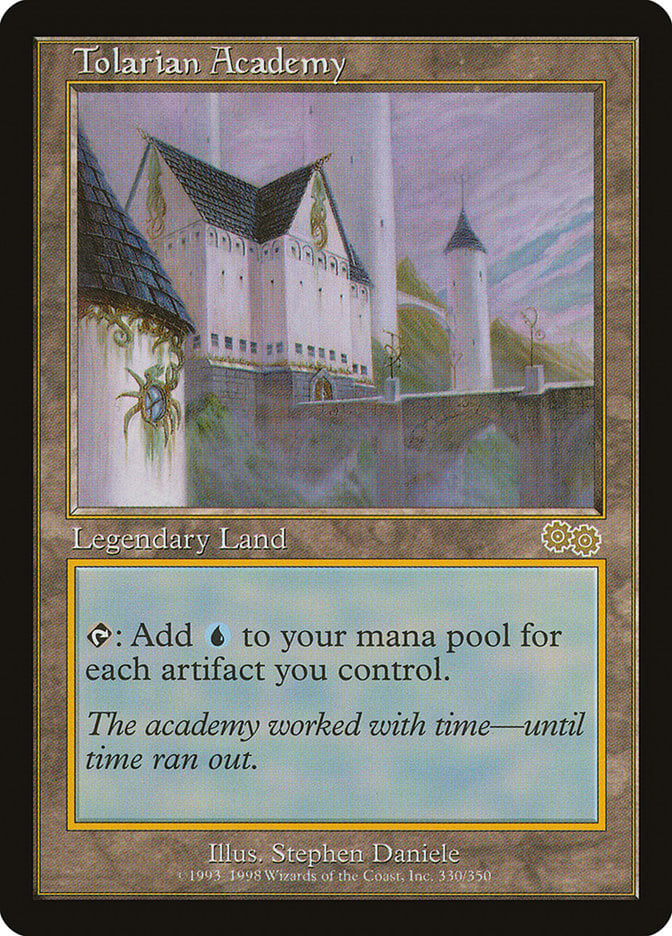
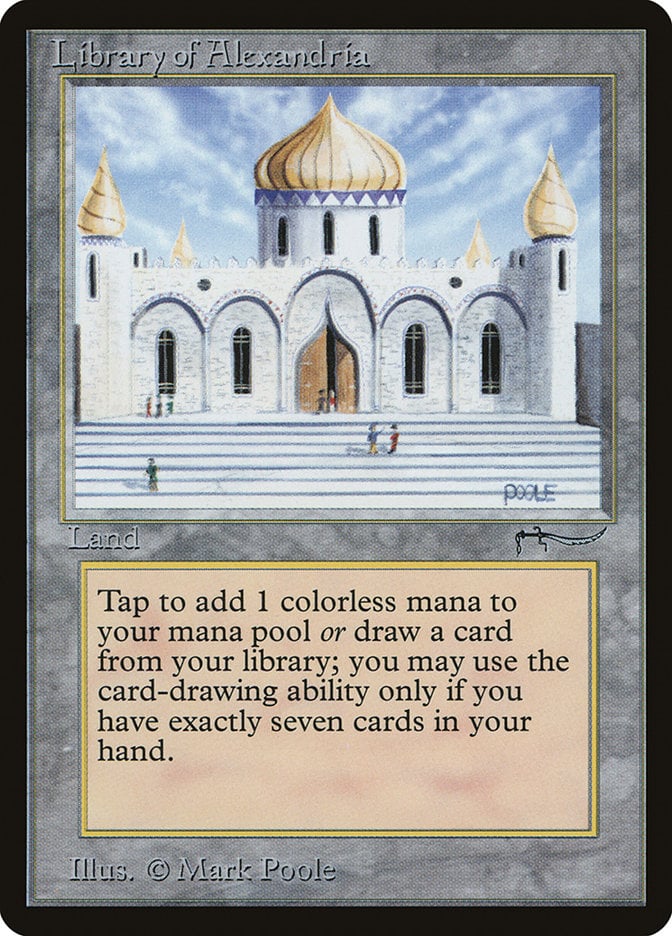

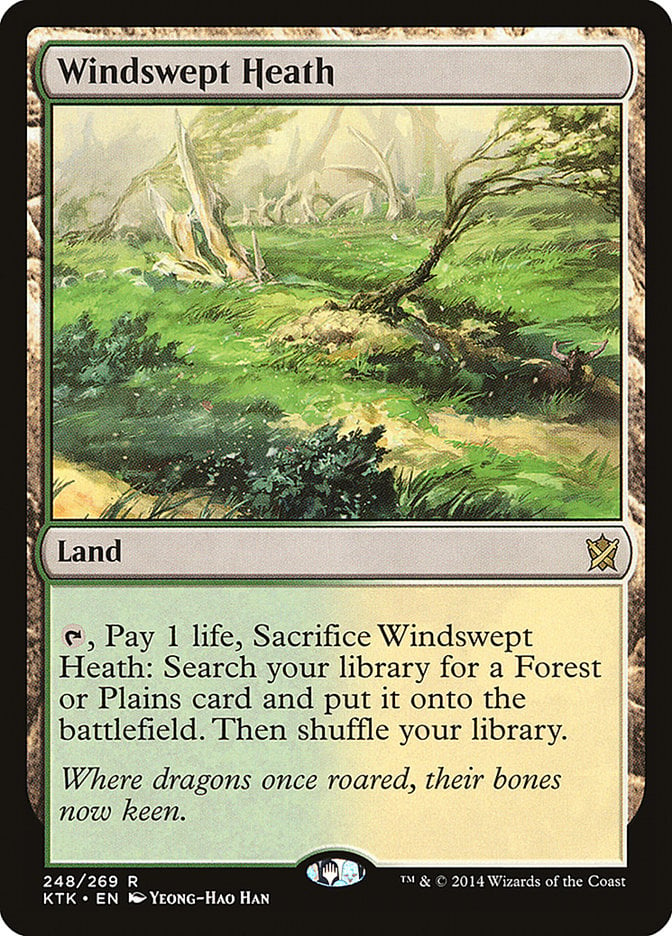


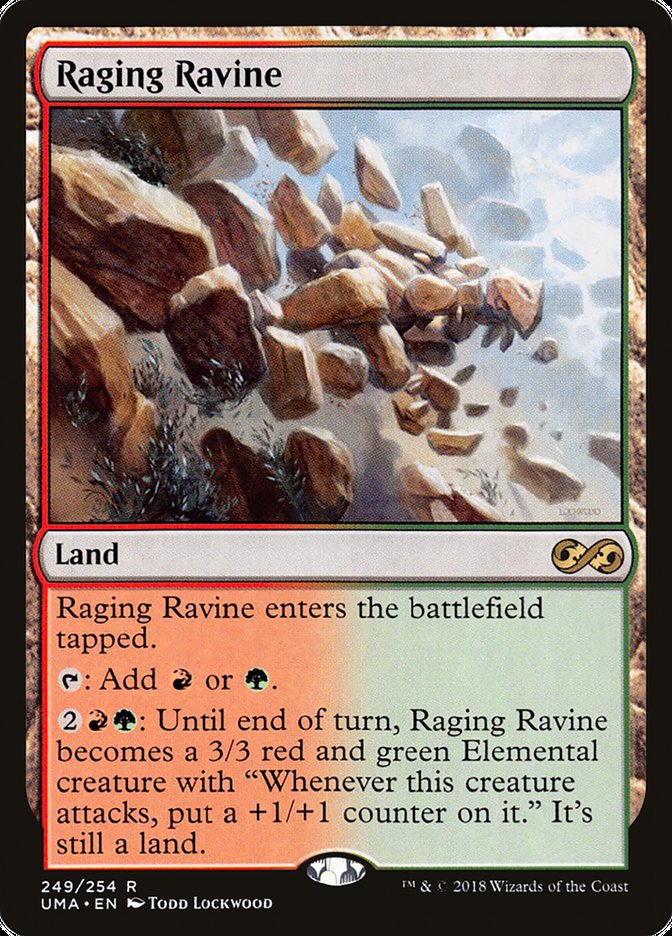

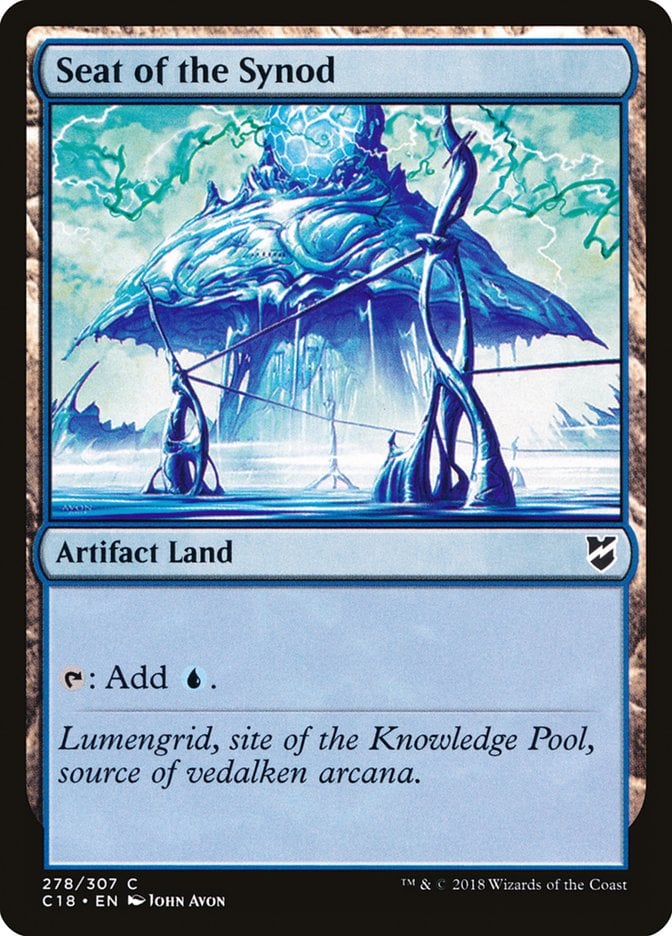
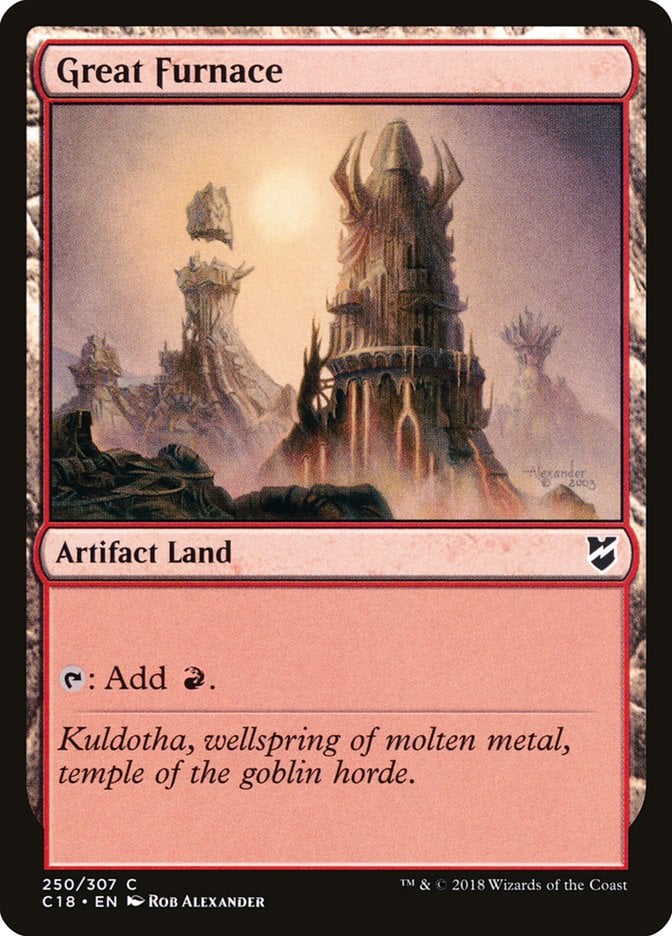
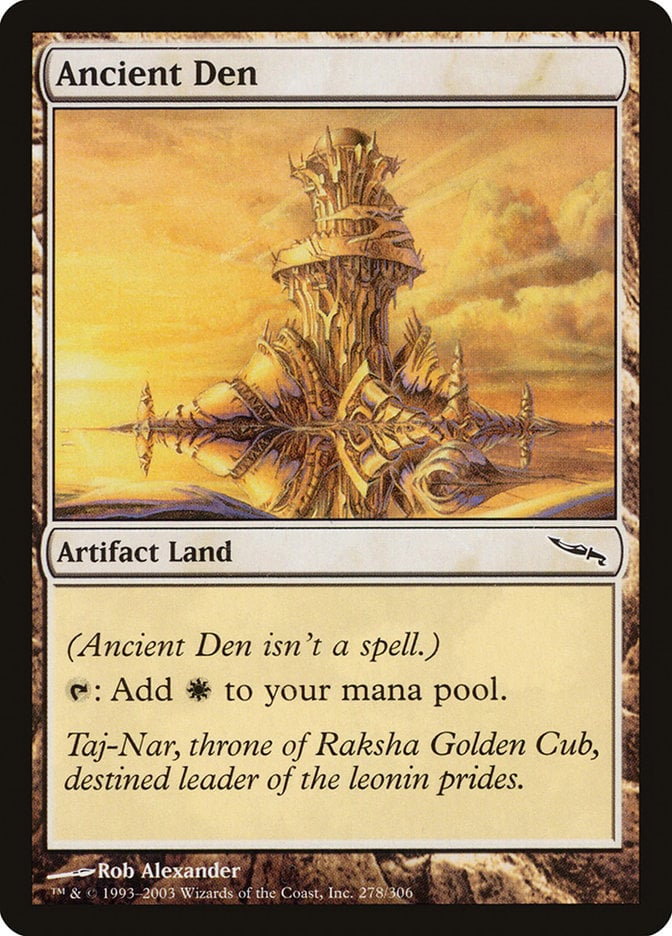
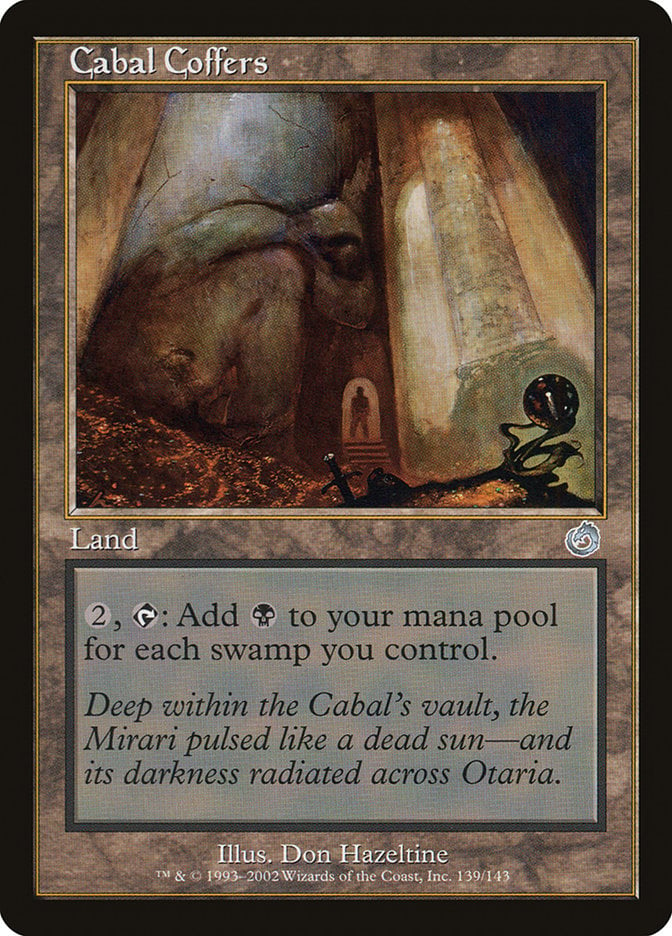

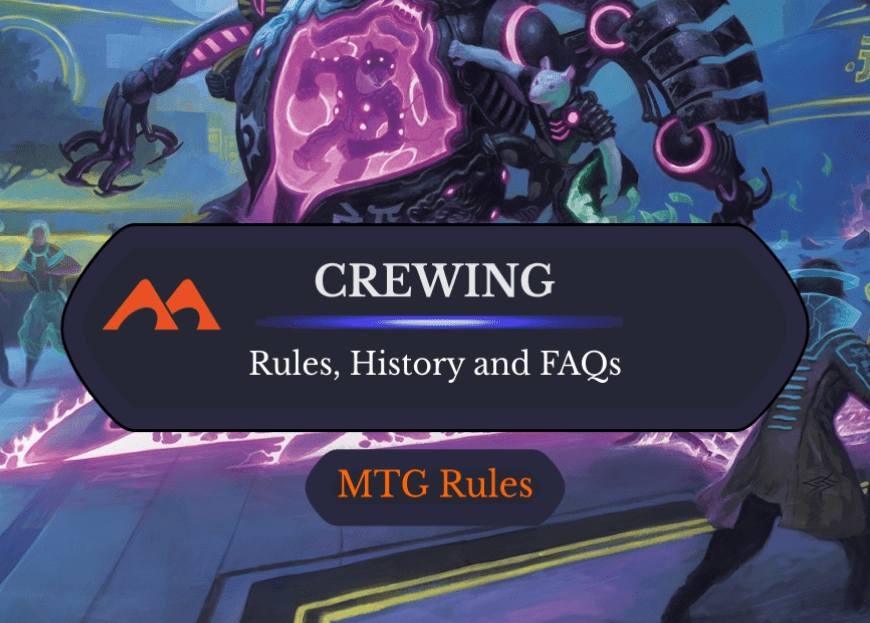
2 Comments
stating Kessig wolf run it’s +X/+0 not +X/+X
Fixed, thanks!
Add Comment